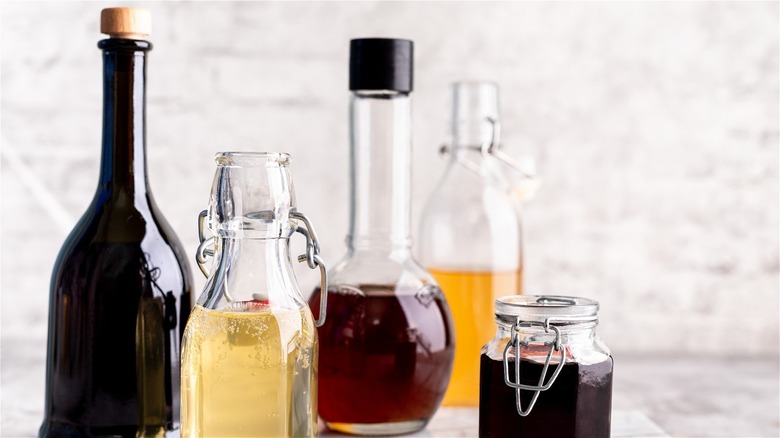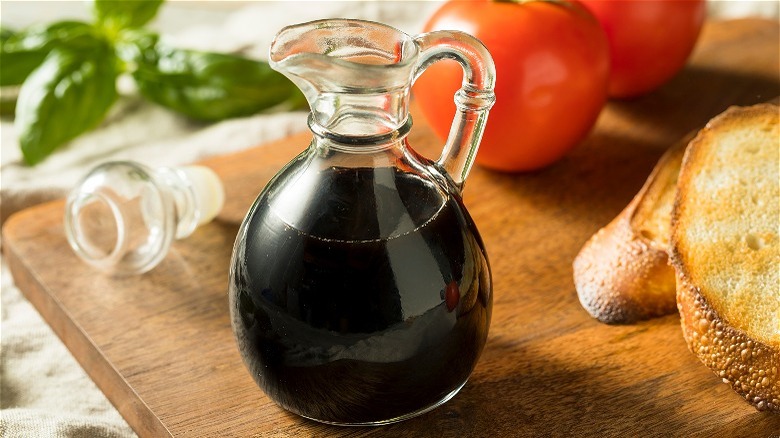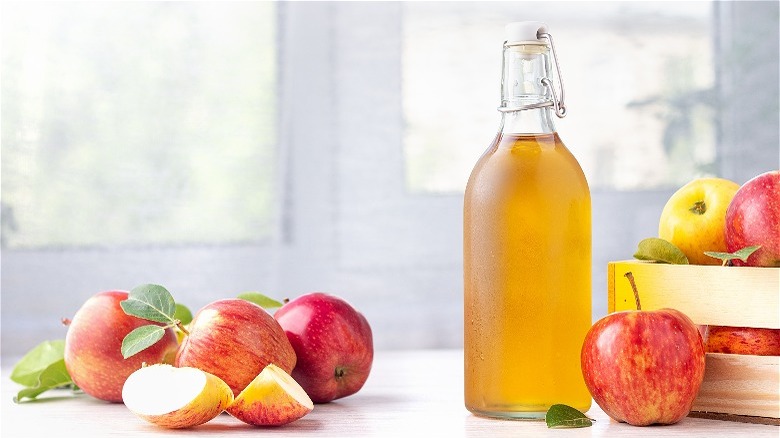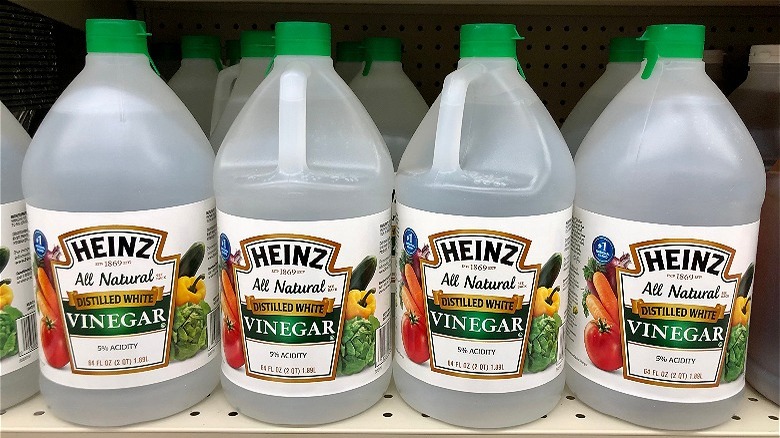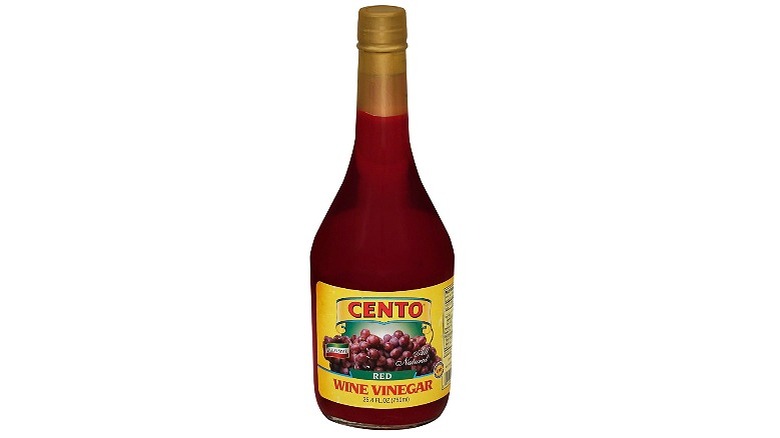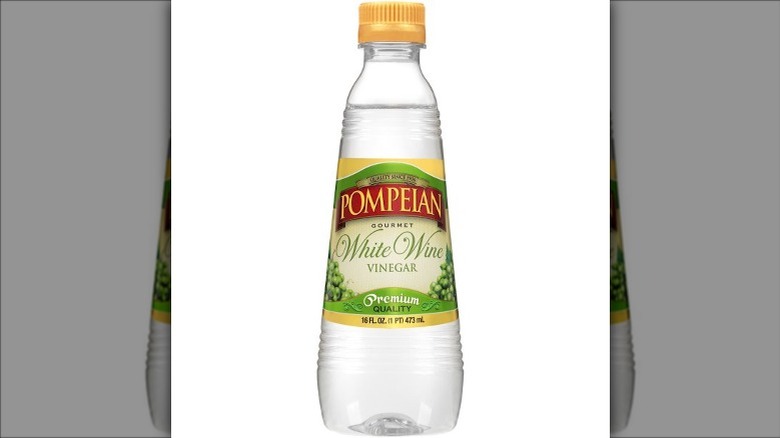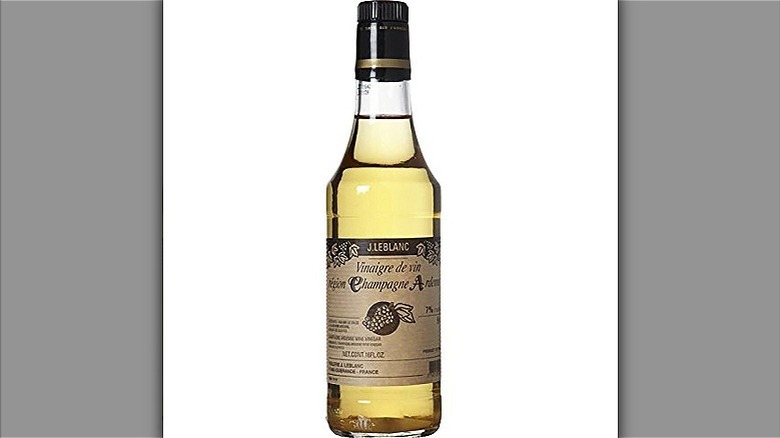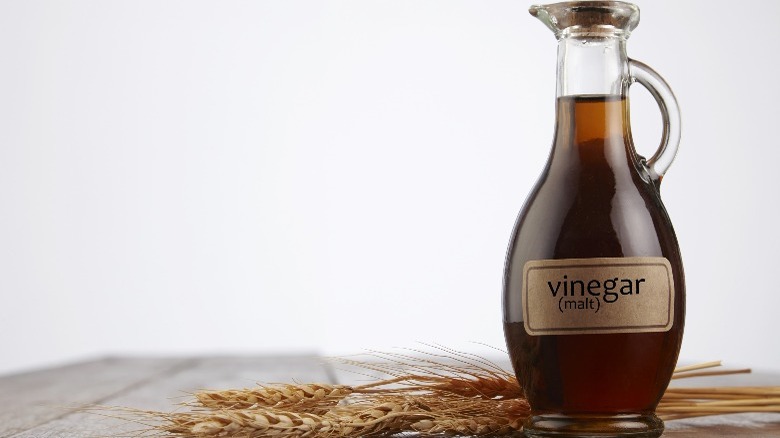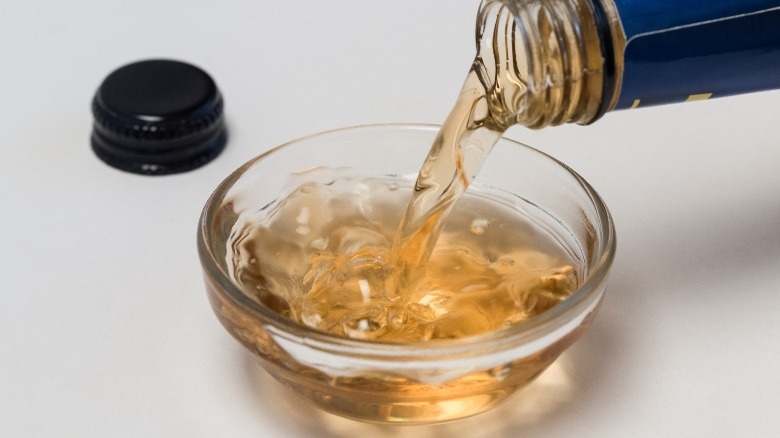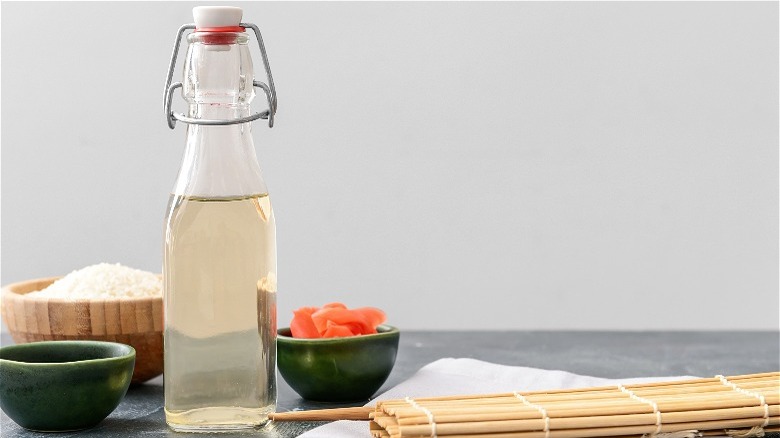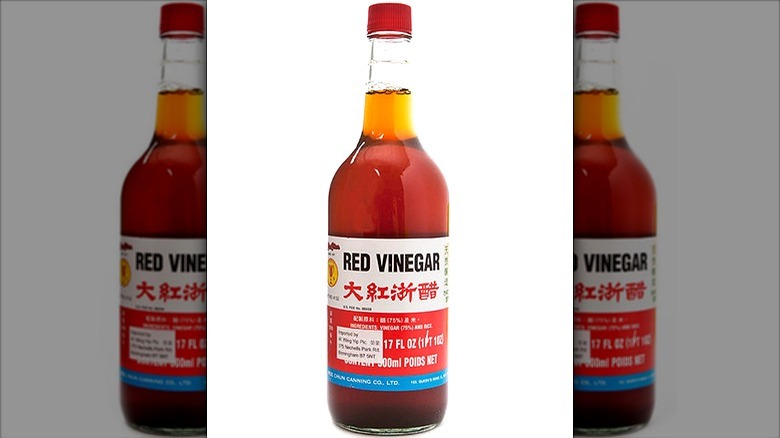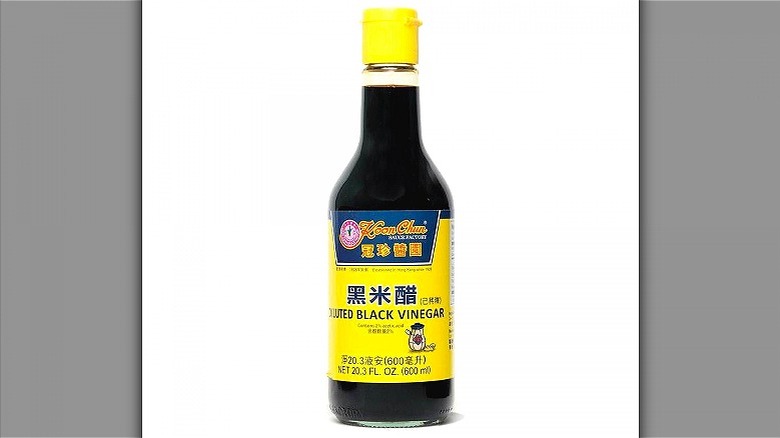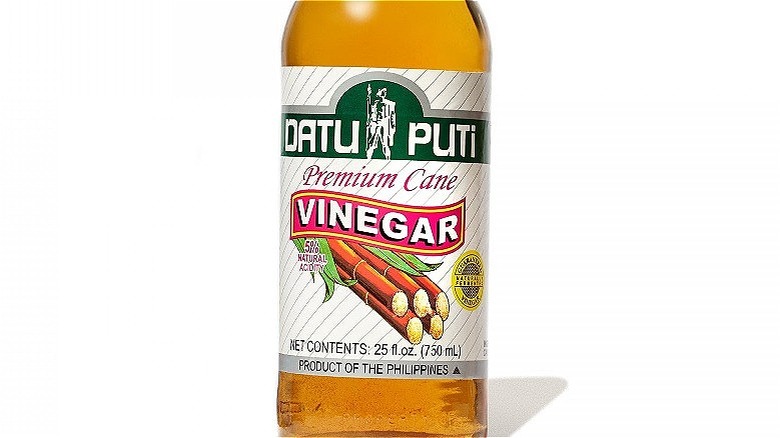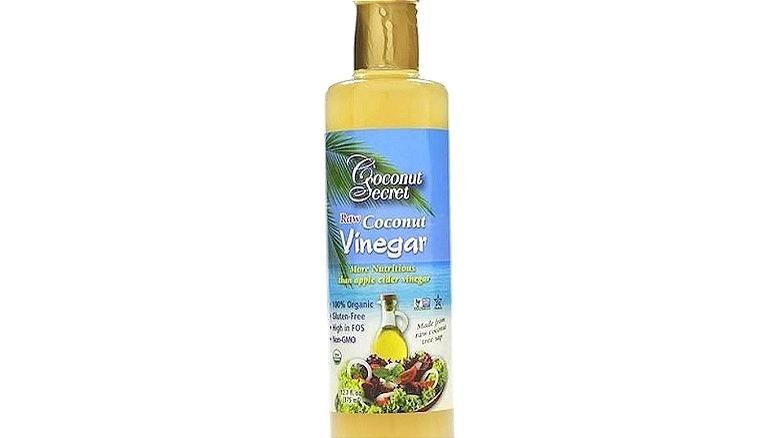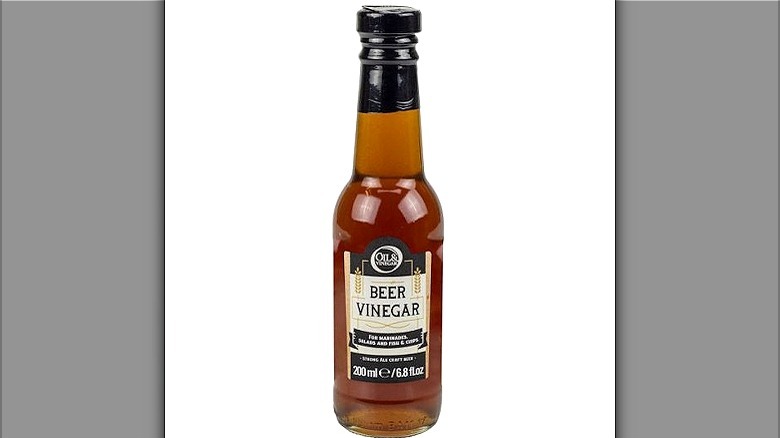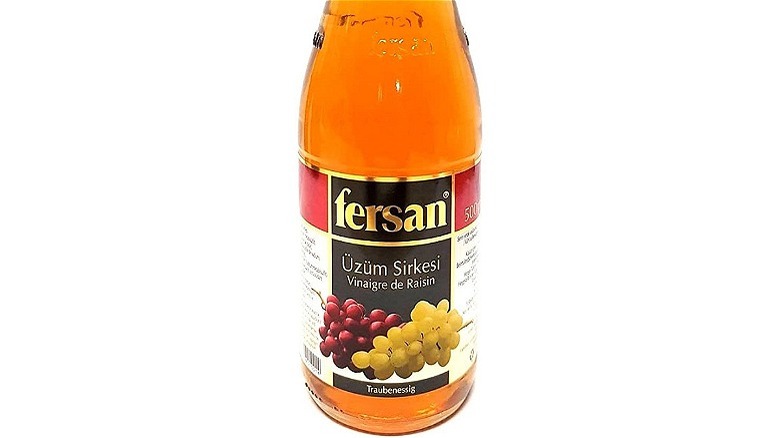15 Different Types Of Vinegar Explained
Vinegar may not seem like the most exciting pantry staple. You buy a bottle, you put it in the cupboard, and it may stay there for years to come. It doesn't seem as essential as oils, nor as delicious as seasonings. Plus, the many different kinds available can cause confusion.
When should you reach for the white vinegar over sherry vinegar? We may possess a bottle of distilled white vinegar already, but isn't that only used for cleaning? Then there are those like balsamic vinegar, which we seem to bring out for set uses like topping our salads or pizzas. Unless we know how to get creative, malt vinegar stays with our British fish and chips, and rice vinegar may only get used for a Chinese stir-fry.
But we're here to end the uncertainty. When used properly, vinegar is an extremely helpful ingredient. After reading this, you'll learn how to use various types of vinegar — as easily as you already make use of different oils. You'll be confident in numerous vinegar cooking applications. You'll learn about unexpected vinegar uses, from roasting vegetables to making pie crust. Here are 15 different types of vinegar, explained.
Balsamic Vinegar
Balsamic is one of the least daunting types of vinegar. Familiar Italian dishes like Caprese salad are generally known for being doused in the stuff. But there's more to know about it.
According to Serious Eats, the first written record of balsamic vinegar dates back to 1046, when the Holy Roman Emperor was presented with a bottle. For a while, balsamic vinegar was only known to those in Italy, especially in the region of Emilia-Romagna — which is home to both Modena and Reggio Emilia (Italian provinces where balsamic vinegar is produced), per Italy Magazine. The provinces still play an important role in producing some of the world's most traditional balsamic vinegars today. However, the production of certain balsamic vinegar varieties is no longer restricted to these areas, reports Food & Wine. In the past, this vinegar had to be produced in Italy to be considered legit.
Grape must, made by extracting juice from pressed grapes, is the only ingredient included in high-quality, "traditional balsamic vinegar," via Simply Recipes. To make, the must is boiled down to a concentrate, fermented, then aged for a minimum of 12 years. Typical grocery store balsamic vinegars are made differently: Must is combined with wine vinegar, then aged for months, not years. Depending on the kind you purchase, your balsamic vinegar may vary in flavor and consistency. However, all vinegars of this kind will be a dark, black color. You can use balsamic vinegar in recipes like salads, entrees, and cocktails.
Apple Cider Vinegar
Apple cider vinegar is known for its health benefits. According to WebMD, consuming it has been touted as a way to lose weight, increase heart health, and improve digestion. But potential wellness improvements are only one aspect of what's to know about "ACV," as some call it.
The vinegar recipe begins with apples. The preparations of those apples can go a few different ways. You can start by chopping apples and covering them with water, then leaving them to ferment (via Going Zero Waste). Or, you can crush apples into apple juice before fermentation begins (via Bragg). As the starting substance sits, yeast breaks down the sugar in the apples. The sugar is next transformed into alcohol. Then, the alcohol is further fermented into acetic acid. As the University of Chicago explains, this is the process of fermentation used to make the vinegar. Sometimes water is then added to reduce acidity.
This vinegar is commonly used for salad dressings, marinades, and in pickling, per Bragg. It's sometimes combined with baking soda then added to vegan cake or cookie recipes (via Vegan Baking). Not surprisingly, this vinegar can be used to make apple cider doughnuts. If there are several cups on hand, you can even make cocktails like Fire Cider with it. Once opened, apple cider vinegar does not need to be stored in the fridge. Per My Recipes, the USDA recommends using your apple cider vinegar within two years.
Distilled White Vinegar
This vinegar is known for non-cooking purposes — usually household cleaning ones. According to Cnet, you can use distilled white vinegar to defog mirrors, remove stains, deodorize items, clean kitchen appliances, and more. There are also beautification uses for distilled white vinegar, such as for whitening your teeth, softening your skin, performing manicures and pedicures, and getting silky hair (via TipsBulletin). And those aren't even all the ways to use the cheap, simple product.
As Food & Wine explains, distilled white vinegar is made when grain alcohol (similar to vodka) is exposed to oxygen. Bacteria form, then acetic acid is created. This is similar to the process used for creating apple cider vinegar. Per Harvard, that's because all vinegars undergo a similar process. At the end of the two-step fermentation process, you have distilled white vinegar.
Distilled white vinegar is sometimes overlooked on the cooking front. That could be because it's made in an industrial setting, reports Epicurious. Coupled with the idea that this vinegar type is mostly used for chores, it doesn't appear that edible. However, it is. One common cooking use is pickling, per the National Center for Home Food Preservation. Another is in pie crust, where it works as a tool that prevents the dough from being overworked (via King Arthur Baking). If neither of these applications sounds useful to you, this vinegar can also help with cooking rice, poaching eggs, and marinating meats.
Red Wine Vinegar
Red Wine Vinegar is a common cooking ingredient that you've probably used before. It's used to make vinaigrettes, pickles, and marinades, according to WebMD. Like other types of vinegar, it's a low-calorie pantry staple. There are around six calories per 100 grams of red wine vinegar (via LiveStrong).
This type is one of a few kinds of vinegar made from wine. First red grapes are fermented, becoming red wine; in turn, the red wine ferments once again, creating a sour-tasting liquid, explains The Cookful. After this second process, the resulting vinegar can't get you drunk, though it will still contain trace amounts of alcohol (per Supreme Vinegar, most vinegar types contain between 0.3% and 0.4% ABV. That's around the same amount — or sometimes even less — than is found in kombucha, according to Healthline).
As for other uses in the kitchen, red wine vinegar's properties enable it to do certain things. To start, if you want to turn something slightly pink, red wine vinegar can help with that (via Masterclass). The vinegar imparts hue to whatever it touches. Red wine vinegar can also help in places where tangy, sweet, or fruity flavors are welcome, helping to create a more balanced flavor in savory dishes of red meats, beans, and lentils (via Martha Stewart).
White Wine Vinegar
While there's an obvious (but slight) difference between white vinegar and distilled white vinegar, there's an even larger difference between those and white wine vinegar. This wine-based product has more in common with red wine vinegar. They're made the same way, just with different grapes.
You'll be able to tell this wine vinegar apart based on its color. It will be white to yellow-white, and clear. The flavor is going to be different, as well. According to Fine Cooking, all wine vinegars — like white wine vinegar — are milder and less acidic than white distilled or cider vinegars. White wine vinegar is also less tangy, sour, and sweet than red wine vinegar and balsamic vinegar, per MasterClass. Overall, the taste is clear and mild.
The less severe flavor of white wine vinegar lends itself to lighter foods — for instance, it works well on picnic favorites like coleslaw and potato salad, according to Masterclass.
Champagne Vinegar
In this classy-seeming vinegar, there usually isn't any Champagne. This pantry staple is typically made from Pinot Noir and Chardonnay grapes (via MasterClass), which — along with Pinot Meunier — are the main varieties used to sometimes make Champagne, per Wine Enthusiast. As Taste Essence explains, champagne vinegar is called such because it's made from the same grapes used to create the celebratory alcoholic beverage. And if you want to find a champagne vinegar that's from France, authentic French champagne vinegar is called "le vinaigre de Reims," explains Easy French Food. The name comes from Reims, a city in the region of France where champagne grapes are grown (via Britannica).
The flavor is the reason to turn to champagne vinegar over other types. The Cookful describes it as a "dry white wine vinegar." You'll add less sweetness to your recipes by choosing this vinegar over others. Brightland says it's milder than white wine vinegar, rice vinegar, or sherry vinegar, making it a great addition to some light vegetable, fruit, chicken, and fish dishes. A squirt of citrus may be more similar to it than other kinds of vinegar — that's how delicate it is.
Malt Vinegar
Unlike other types on this list, malt vinegar is typically used as a condiment, not a cooking ingredient (via The Kitchn). You may have come across this one in the United Kingdom, or at pub restaurants. That's because malt vinegar is applied as a topping to fish and chips. Overseas, it usually comes in a bottle that is splashed over a fried plate of cod and french fries by customers.
Malt vinegar's creation also begins with alcohol. Barley is first malted. During this first step, barley grains are immersed in water, causing them to sprout and activate enzymes that convert sugars into alcohol (via Michigan State University). Next, that malted barley is brewed into a liquid similar to ale. Finally, that liquid is fermented once more, turning the alcohol into vinegar, per The Kitchn. At the end of the process, you have a bottle of fluid that is usually brown in color.
This type of vinegar is far from the delicate flavors of champagne vinegar. It's more intense, but not so much that it's not a crowd-pleasing topping. Fine Cooking describes the taste of malt vinegar as dark and flavorful. Food Republic called it toasty, nutty, and rich. Given all that flavor, it can be dangerous to use malt vinegar on delicate foods or in mild recipes. Don't put this vinegar into your salad dressing. Instead, you can malt vinegar with warm, starchy meals like beans on toast, another British classic.
Sherry Vinegar
Sherry vinegar is often compared to balsamic, which is the more well-known of the two, but not necessarily always the better option. According to Serious Eats, sherry vinegar is more affordable than the Italian stuff (and even some of its cheaper imitations). Despite rules around both vinegars' production, you're more likely to end up finding real sherry vinegar at the grocery store, compared to balsamic. As Bon Appétit says, "the stuff you find in stores labeled sherry vinegar varies comparatively less in quality and has fewer low-quality imitators."
Also like balsamic, sherry vinegar must be made in a particular region of the world. Sherry vinegar, like sherry wine, must legally be produced in the Cádiz region of Spain. Once turned from sherry wine into vinegar, it's made using the "solera" system (per Reluctant Gourmet). During this process, liquids of different ages are blended. To be considered even more legit — and achieve the much-desired designation of "Vinagre de Jerez," which means sherry vinegar — the liquid must undergo additional steps. It must be aged in American oak for a minimum of six months within the "sherry triangle" (an area within Cádiz) and must contain at least 7% acidity.
This vinegar also has unique flavors. The Kitchn reports that the Spanish vinegar's taste is between wine vinegars (which are typically acidic) and balsamic vinegars (which known for tasting bold and powerful) in terms of intensity, calling sherry vinegar "medium-bodied, delicately sweet, and far from overpowering."
Rice Vinegar
Rice vinegar is a pantry staple known for its application in Asian recipes. According to The Spruce Eats, it's been part of Chinese cuisine for thousands of years. But this type of vinegar is more versatile than some know. After you learn the difference between rice wine and rice vinegar, you'll be ready to go, recommends Life Hacker. Put simply, rice wine is the alcoholic beverage that is one step behind rice vinegar. After fermenting rice into rice wine, the liquid is fermented again and rice vinegar is created.
As for the term "rice wine vinegar," don't worry about it. It's the same thing as rice vinegar. "Seasoned rice vinegar" is different. That is simply rice vinegar with sugar and salt added for more taste, explains Cooking Light. Seasoned rice vinegar is typically used for flavoring sushi rice, per MasterClass. Straight white rice vinegar is a clean-tasting vinegar that works as a multi-purpose cooking tool. This is the most versatile, safe term to look for when picking out rice vinegar.
Popular uses for rice vinegar are similar to other types of vinegar used for cooking. You can add a splash while sautéing vegetables for a stir-fry, marinating meats, or mixing into a salad dressing (via On The Gas).
Red Rice Vinegar
Red rice vinegar is one type of rice vinegar. It's distinguished from other kinds of rice vinegar — such as brown rice vinegar and black rice vinegar — by the kind of rice it's made from. According to The Kitchn, red rice vinegar is made from fermented rice called red rice yeast. Sometimes it's also mixed with grains like sorghum and barley. To turn those grains into vinegar, they undergo the same two-step fermentation process as other vinegar types.
The color of red rice vinegar comes from this unique rice mixture. Instead of a clear white, it appears red. Per The Woks of Life, the taste also differs from typical rice vinegar. It's tart and sweet with a flavor similar to wine.
The acidity is also lower than average vinegar types, coming in at around 2.5%. Red rice vinegar is most commonly used for some Chinese congee, broth, and soup recipes. You can sometimes find it under the name "Chinese Red Vinegar" (via Acid League).
Black Vinegar
Black vinegar is another type of rice vinegar — meaning the process of making it also begins with those particular grains, usually. According to Bon Appétit, the variety of grains used to make black vinegar can vary based on where it's from. Korea and Japan use brown rice to make theirs. Taiwan's is made from sticky rice infused with different vegetables. In China (the place where the vinegar originated), there are four different kinds of black vinegar. Different grains provide the base for each type of Chinese black vinegar.
Per The Woks of Life, other common names for black vinegar include "black rice vinegar, dark vinegar, Chinkiang vinegar, or Zhenjiang vinegar." The acidity can vary, but black vinegars are typically more acidic and less sweet than red rice vinegar. Overall, it's more middle-of-the-road in flavor (despite its intense, rich color). You're most likely to come across a bottle of black vinegar on your table at a Chinese dumpling restaurant. Use it to enhance the flavor of those dumplings as a topping or dipping sauce.
Like other kinds of vinegar, you can use black vinegar to improve recipes like salad dressings or sauces. By doing so, you "will brighten the flavor and prevent the food from feeling too heavy" (via The Daring Kitchen).
Cane Vinegar
This is another vinegar type that's associated with a specific cuisine. In the case of cane vinegar, it's Filipino food. According to Epicurious, cane vinegar is made from molasses. The product originated from the prevalence of sugar refineries in the Philippines. For Filipino recipes, it's used to make popular dishes like adobo or dinuguan (Filipino blood stew). However, cane vinegar is also common in France or Louisiana. You can see its use in the American state in this Southern recipe for glazed chicken.
Per CooksInfo, the process of making cane vinegar begins with sugarcane. Sugarcane is turned into molasses, which is then fermented into vinegar. Then, the process diverges. Higher-end cane vinegars are then aged in oak barrels. Others head straight to bottling. You'll find that the resulting color of cane vinegars ranges from yellow to brown.
Cane vinegar is not known for being sweet. Instead, it has a taste that's "mildly sharp," according to Delighted Cooking. As with other types, cane vinegar is recommended for deglazing purposes (via Recipe Tips). The process of deglazing happens when you pour liquid over a pan to loosen the burning bits from the bottom, allowing both the flavor of the vinegar (and those slightly burnt food pieces) to mix with the rest of your food. Although it may not sound so delicious, it's a method used by trained chefs to enhance their recipes (via Fine Dining Lovers). Vinegars such as cane vinegar are a great liquid to use to do this.
Coconut Vinegar
Coconut vinegar is commonly found in recipes from certain Asian cuisines. You might find it in recipes from South Asia, such as in Indian cuisine, or Southeast Asia, such as in Thai or Filipino cuisines (via Healthline).
This vinegar is made from coconut trees, but not from the coconuts themselves. Instead, sap is extracted from the trees' flowers. The liquid ferments, becoming an alcoholic drink known as "toddy," explains Epicurious. Then it ferments a second time, becoming coconut vinegar. Don't expect the resulting flavor to be heavy on the coconut. It's not so sweet either, as some coconut-flavored products can be. Instead, it's mild and complex. Coconut vinegar has been compared in taste to champagne vinegar, meaning it could be a delicate addition to your cooking.
In addition to Asian cuisine, you'll find applications for coconut vinegar in Mexican cuisine as well. It's used in this recipe for Tatemado de Colima, a braised pork recipe that results in some deliciously tender taco meat. According to The Coconut Company, using this vinegar in your cooking may come to benefit your health, as well. Coconut vinegar may be able to improve your digestion, immunity to diseases, heart health, and more.
Beer Vinegar
Beer vinegar is vinegar that comes from beer. You may be tempted to recall malt vinegar, which is somewhat similar to beer vinegar — but maybe not much more than other vinegar types are. According to American Vinegar Works, one key difference is in the alcohol used to make malt or beer vinegar. You would never drink the alcohol used to make malt vinegar. However, beer vinegar is typically made from digestible alcoholic brews. Despite their differences, they have things in common, as well. You can use beer vinegar similarly to malt, by splashing your fish and chips with it.
Esquire explains a simple method for making malt vinegar, in which raw apple cider is added to any brew of your choosing. You can even turn drinks like PBR into beer vinegar, using this or other methods. One method described by Supreme Vinegar recommends adding "mother of vinegar" to your beer to begin the process. This is a standard ingredient made of cellulose and acetic acid, and is used to begin fermentation in the process of making many kinds of vinegar (via Vinegar Shed).
You might come across beer vinegar while trying out Nordic recipes, per Honest Food. This recipe of sautéed mushrooms and radishes is one way to test out beer vinegar's uses within Scandinavian cuisine.
Raisin Vinegar
Raisin vinegar is a type of fruit vinegar. It has been used historically in Middle Eastern cuisine, particularly in countries such as Turkey, according to Turk Food Recipes. It's typically used there for pickling foods or for medical uses as a weight loss supplement.
To make raisin vinegar, you add alcohol to the raisins and let the fun begin (via Pro Home Cooks). The resulting color will be a cloudy, orange-brown (via Turkish Grocery). The flavor is milder than other kinds of vinegar. Reviewers on Steemit compared the flavor to balsamic, saying of their attempts at making it, "I just decided to try making vinegar with raisins one day and fell in love with it, better than I expected it would be and not really sure how to describe it but not like balsamic, I would say smoother than that." Other ways to use raisin vinegar are in Italian recipes such as agrodolce sauce (via WebstaurantStore).
